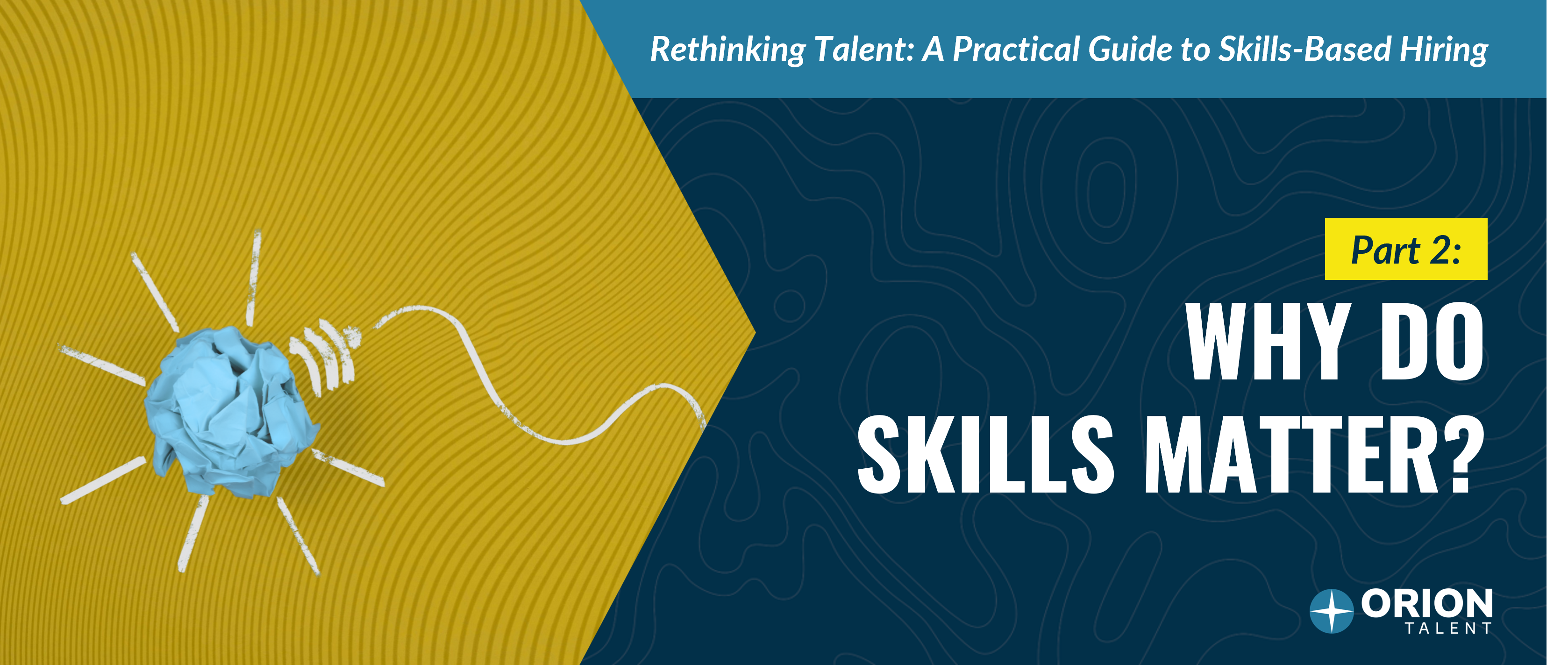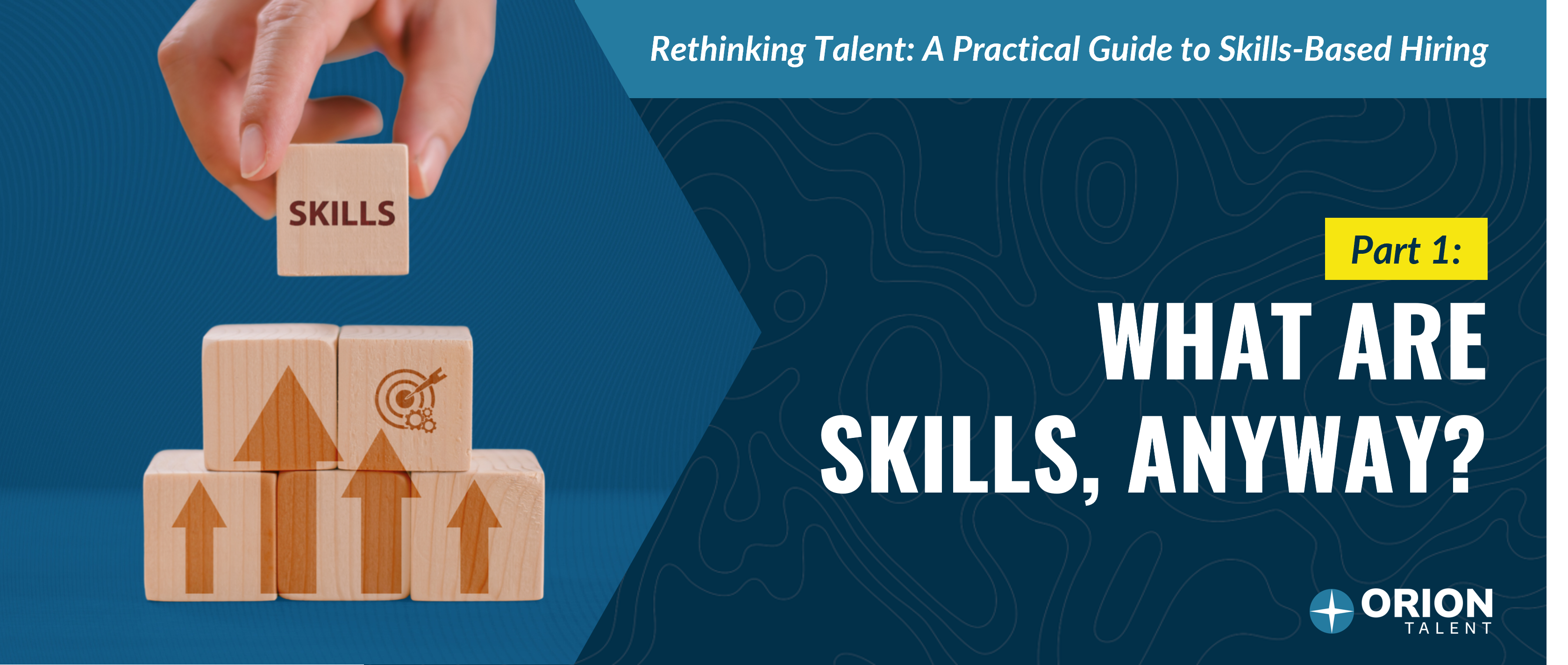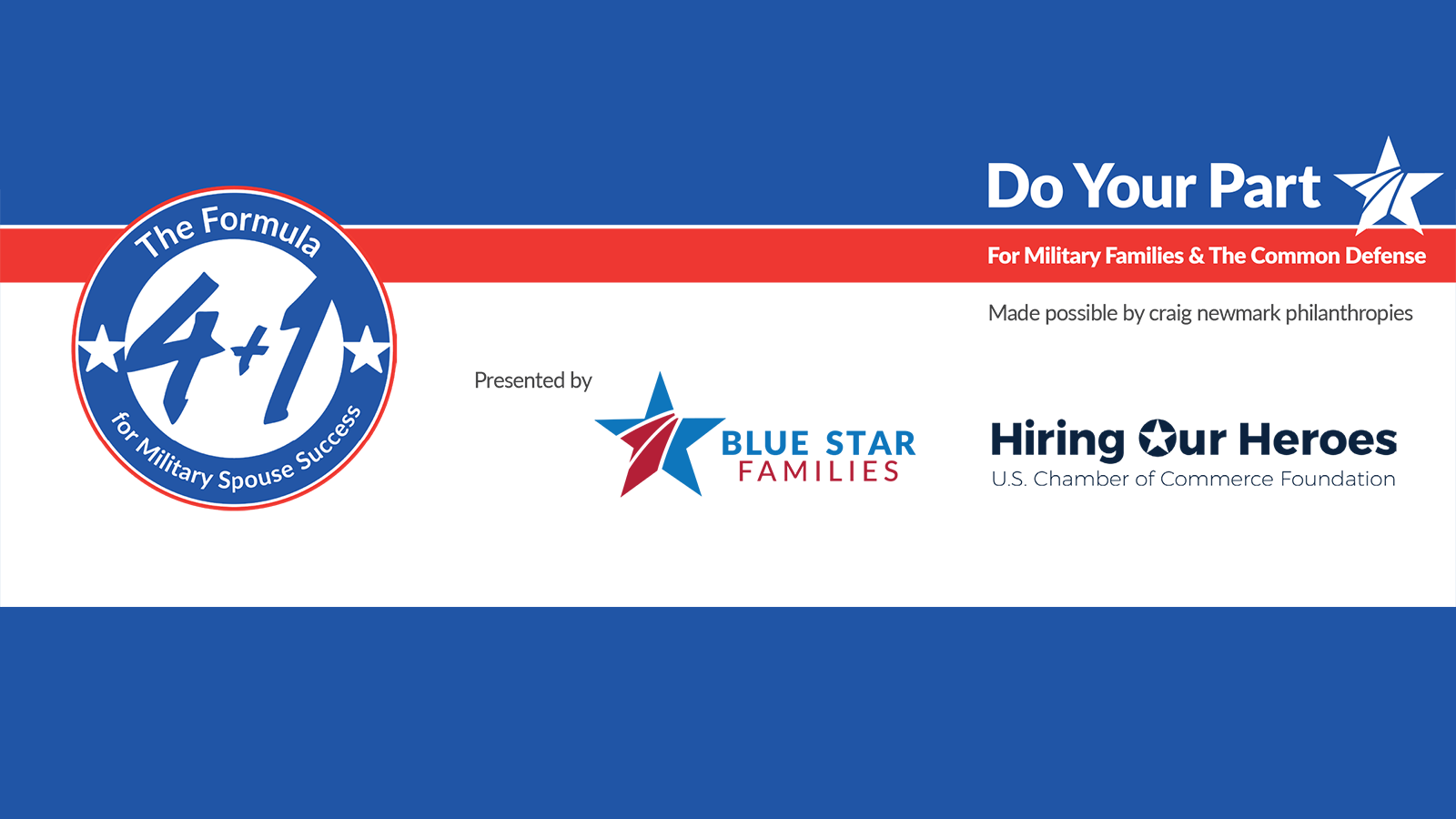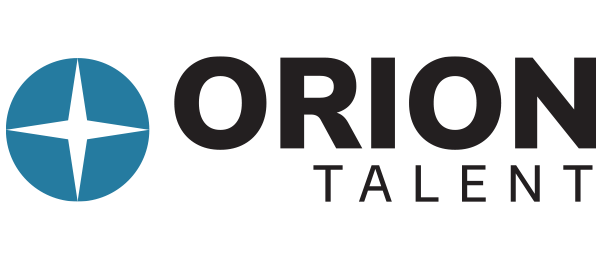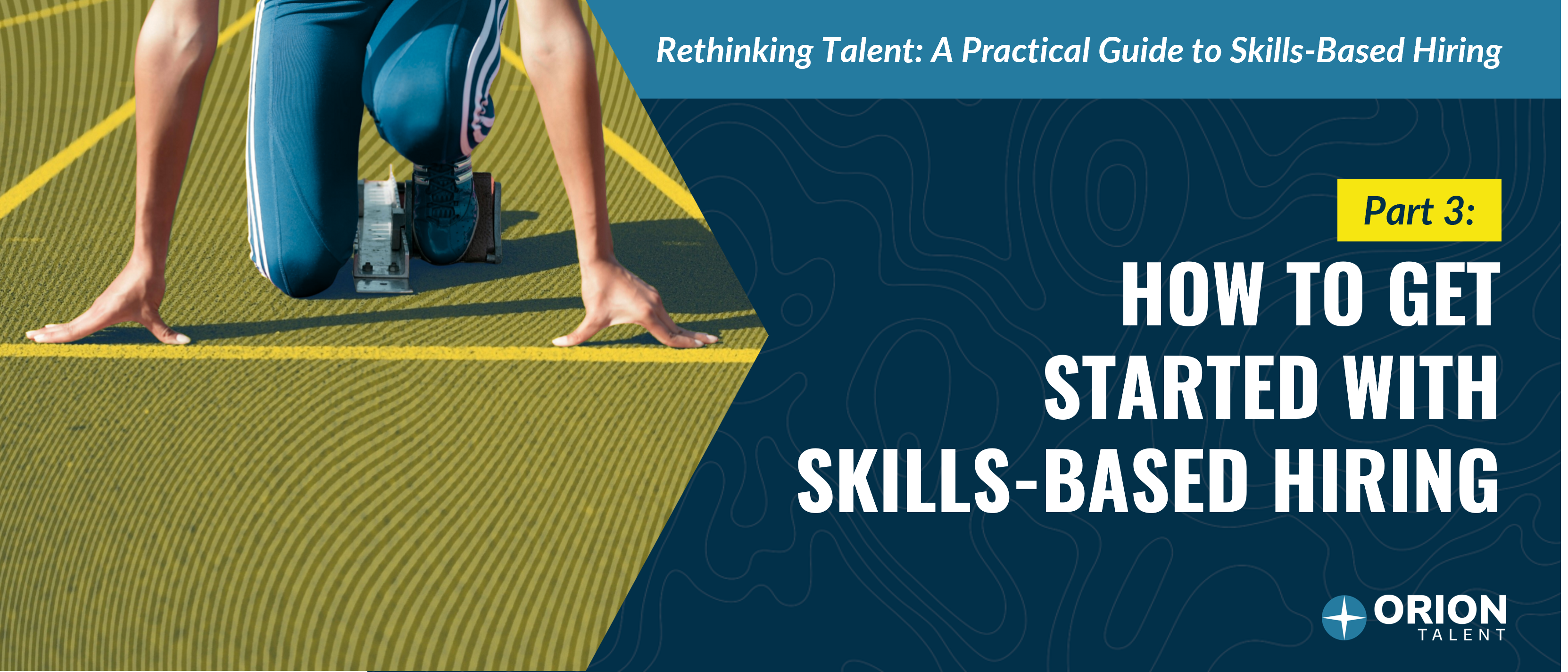
Written by: Stefan Lint, Talent and Workforce Solutions Advisor
PART 3. HOW TO GET STARTED WITH SKILLS-BASED HIRING
Read Part 1: What Are Skills, Anyway?
Read Part 2: Why Skills Matter
It's one thing to recognize the power of skills in today's business world; it's another to figure out how to actually start leveraging them within your organization. For HR and business leaders the idea of a comprehensive skills strategy might seem daunting. But here's the good news: you don't have to overhaul everything overnight. The best way to begin is with a focused pilot program to demonstrate impact, earn buy-in, and build momentum.
Let's explore how you can effectively kickstart your skills strategy and demonstrate its value.
Why a Pilot Program?
Implementing a full-scale skills strategy across your entire organization can be complex. A pilot program offers a low-risk, high-learning approach. It allows you to:
- Test the waters: Validate your assumptions and identify what works (and what doesn't) in your specific environment.
- Demonstrate value: Show tangible results to stakeholders and build momentum for broader adoption.
- Learn and iterate: Refine your processes and tools before a wider rollout.
- Manage change: Introduce the concept of a skills-based approach incrementally, without overwhelming or disrupting employees.
Choosing Your Pilot Area: Where to Begin?
The key to a successful pilot is selecting an area where you can see clear benefits and manage the scope. Consider these factors:
1. A Department or Team with Clear Skill Gaps: Do you have a specific department that's struggling to find certain expertise, or where current employees need significant upskilling due to new technology or processes? For instance, if your company is adopting advanced robotics in a specific manufacturing line, that team's skills would be an excellent starting point.
2. A Critical Role or Job Family: Is there a particular skilled trade role that's notoriously difficult to fill, or where turnover is high? Focusing on the skills required for this role could yield significant insights and improvements in your talent acquisition efforts. Think specialized welders, CNC machinists, or master electricians.
3. A Specific Business Problem: Is there a particular recurring business challenge you're facing that you suspect is skill-related? Perhaps quality control issues stemming from a lack of specific diagnostic skills, or project delays due to insufficient project management capabilities within a team.
4. An Open-Minded Department or Manager: Choose a team or a manager who is open to innovation, understands the value of skills, and is willing to collaborate closely with HR. Their enthusiasm can be infectious and will help drive success.
Steps to Launching Your Pilot Skills Strategy
Once you've identified your pilot area, here's a step-by-step guide to get started.
1. Define Your Pilot Scope and Objectives
Be crystal clear about what you want to achieve with this pilot. Do you want to:
- Improve time-to-fill for a specific role by 20%?
- Identify critical skill gaps in a department and create development plans for 70% of employees?
Increase internal mobility for a priority skill set? Reduce training costs for a specific area by improving targeted training
2. Identify and Define Key Skills
This is the core of your pilot. For your chosen department, team, or role, collaboratively work with subject matter experts (SMEs)—your most experienced tradespeople and supervisors—to create a list of the essential skills required.
- Go granular: Instead of "welding," specify "TIG welding on stainless steel" or "MIG welding for structural components."
- Include human skills: Don't forget crucial capabilities like analysis, problem-solving, safety compliance, blueprint reading, and skills for leaders such as leading meetings, delegation, assessing team performance.
- Establish proficiency levels: For each skill, define what "basic," "intermediate," and "advanced" proficiency looks like. This provides a clear benchmark.
3. Assess Current Skill Levels
There are various ways to do this, even in a pilot:
- Self-assessments: Have employees assess their own proficiency against the defined skills. Provide clear guidelines.
- Manager assessments: Managers can evaluate their team members' skills using these same guidelines.
- Peer feedback: In some contexts, peer evaluation can offer valuable insights.
- Observation/Certification: For hands-on trades, direct observation or existing certifications are powerful indicators.
- HRIS data: Leverage any existing training records or certifications in your HR system.
4. Analyze the Gaps and Develop Action Plans
Compare the required skills with the current skill levels. This will highlight your immediate skill gaps. Based on these gaps, develop targeted action plans.
- Training: Identify specific courses, workshops, or certifications.
- Mentorship: Pair employees with skill gaps with internal experts.
- Cross-training/Job Rotation: Provide opportunities for employees to gain hands-on experience in new areas.
- Recruitment: For critical gaps that cannot be filled internally, refine your job descriptions to reflect the specific skills needed for external hiring.
5. Implement and Monitor
Roll out your action plans and continuously monitor progress. Track your pilot's results. Are you meeting the objectives defined in Step 1? Are you seeing improvements in time-to-fill? Are employees progressing in their skill development?
6. Evaluate and Communicate Results
Once your pilot period concludes (e.g., 3-6 months), thoroughly evaluate its success against your initial objectives. Document the challenges, successes, lessons learned, and, most importantly, the tangible impact on your business. Present these findings to senior leadership and other stakeholders. Use this data to advocate and plan for expanding adoption to other roles, functions, etc.
From Pilot to Practice
Starting a skills strategy doesn't require a massive initial investment or team of consultants. You need a plan and the willingness to test, learn, and adapt.
By selecting a focused pilot area, collaborating with your subject matter experts, and demonstrating clear results, you can build a compelling case for a broader, more impactful skills-based approach. This incremental approach will not only make the process manageable but also ensure that your skills strategy is truly tailored to the unique needs of your organization and its highly valued skilled trades workforce.
This concludes our 3-part series, “Rethinking Talent: A Practical Guide to Skills-Based Hiring.” (If you missed Part 1 – What Are Skills, Anyway? or Part 2, Why Skills Matter, be sure to check them out.)
Would you like to explore how Skills-Based Hiring can work within your organization? Contact us to start the conversation.
Archives
- December 2025
- November 2025
- October 2025
- September 2025
- August 2025
- July 2025
- June 2025
- May 2025
- April 2025
- March 2025
- February 2025
- October 2024
- May 2024
- March 2024
- February 2024
- January 2024
- December 2023
- November 2023
- October 2023
- September 2023
- August 2023
- July 2023
- June 2023
- May 2023
- April 2023
- March 2023
- February 2023
- January 2023
- December 2022
- November 2022
- October 2022
- September 2022
- August 2022
- July 2022
- June 2022
- May 2022
- April 2022
- March 2022
- February 2022
- January 2022
- December 2021
- November 2021
- October 2021
- September 2021
- August 2021
- July 2021
- June 2021
- May 2021
- April 2021
- March 2021
- February 2021
- January 2021
- December 2020
- November 2020
- October 2020
- September 2020
- August 2020
- July 2020
- June 2020
- May 2020
- April 2020
- March 2020
- February 2020
- January 2020
- December 2019
- November 2019
- October 2019
- September 2019
- August 2019
- July 2019
- June 2019
- May 2019
- April 2019
- March 2019
- February 2019
- January 2019
- December 2018
- November 2018
- October 2018
- September 2018
- August 2018
- July 2018
- June 2018
- May 2018
- April 2018
- March 2018
- February 2018
- January 2018
- December 2017
- November 2017
- October 2017
- September 2017
- August 2017
- July 2017
- June 2017
- May 2017
- March 2017
- February 2017
- January 2017
 RSS Feed
RSS Feed

